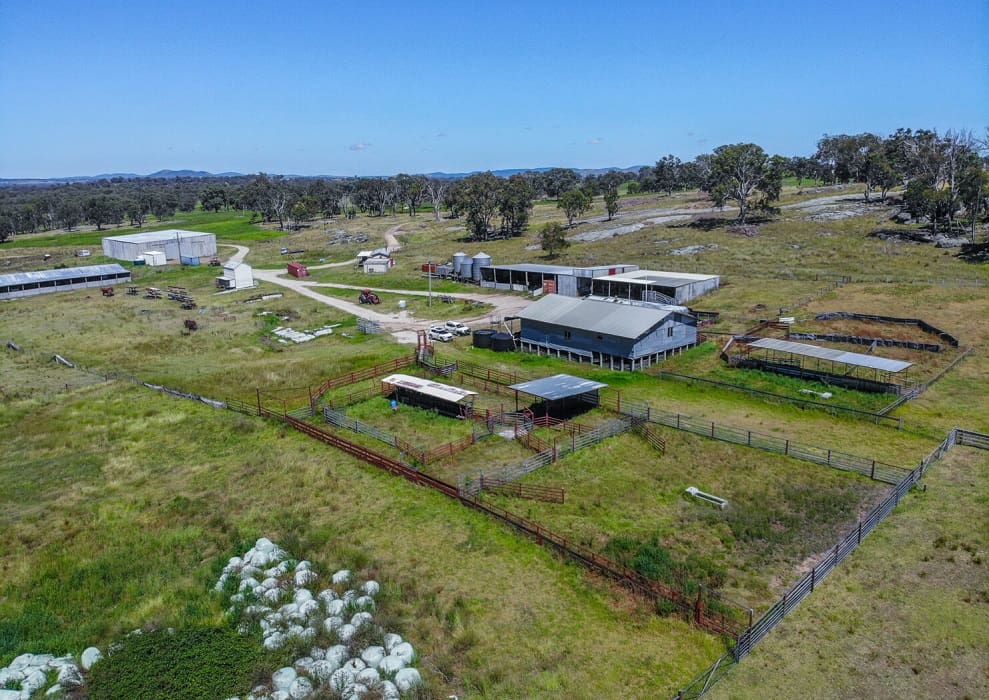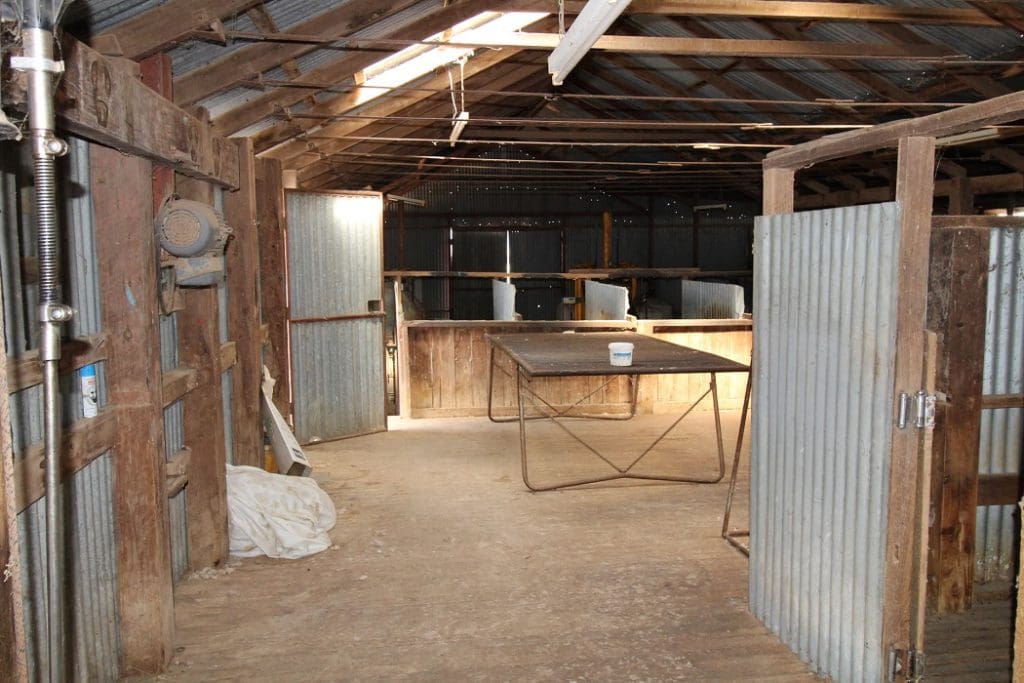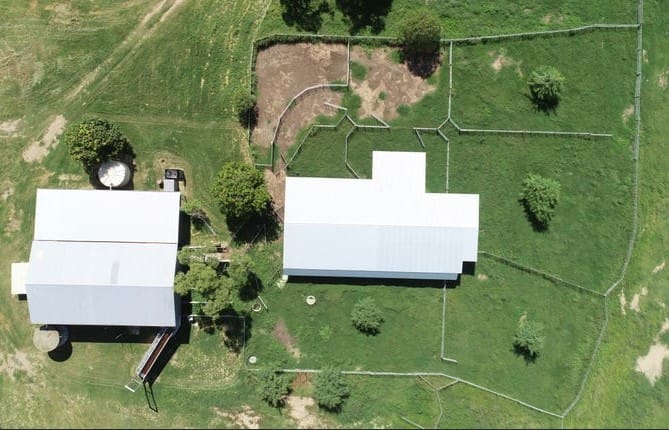A FARMING family from New South Wales’ south-west slopes is expanding its existing operations with Stonehaven in the renowned Holbrook district.
Last year, 1295ha were offered to the market via expressions of interest by fourth-generation dairy farmer Travis Cox and wife Julia after purchasing the property in 2019 for in excess of $11m.
Elders agent David Gittoes was unable to disclose the buyer or the price paid, but said despite last year’s testing market conditions (commodity prices, interest rates and BOM forecast), the price met the vendors’ expectations.
Stonehaven is situated 19km north of Holbrook and 76km south of Wagga. It once formed part of the historic 28,300ha Kinross Station held by generations of the Ross family.
In 2016, more than 100 years of Stonehaven ownership ended when Neil and Jacqui Ross sold and moved to Albury for education reasons.
The country is a balance of productive alluvial creek flats to gentle rising red loam to low granite hill grazing making it suitable for grain, fodder and livestock production capable of running more than 1000 cows.
Mr Gittoes said when the Coxs purchased the property it was in good condition, but they took it to the next level.
“They finished fully renovating the house, which was substantial, and completed the pasture improvement with lime and fertiliser inputs because, as ex-dairy farmers, they know how to grow grass!”
Stonehaven is located in a secure 675mm to 700mm rainfall district and features quality water infrastructure, including 22 dams, a fully reticulated water trough system and two bores.
Improvements include a circa 1920, seven-bedroom home, a seven-stand shearing shed, sheep yards, steel cattle yards, cattle feed containment yards, six silos and various sheds.
THIS week’s property review includes a wrap-up of interesting recent listings across the country.
Scale in northern NSW offers wind turbine income
SA’s Lake Torrens heads to auction
Hay Plains country commands $10m
Western Downs grazing offers diversity
Scale in northern NSW offers wind turbine income

The Runnymede shearing shed and yards.
Offers over $20 million are anticipated for an aggregation of five Northern Tablelands grazing properties in New South Wales with potential for wind turbine income.
The 4468ha Runnymede Aggregation is situated near Yarrowyck, 36km from Uralla and 42km west of Armidale.
It comprises adjoining holdings Runnymede, Eureka South, Trida, Stonebrook and Sand Creek aggregated by local producer John Kennedy over 23 years.
Currently, the aggregation operates as a cattle and sheep trading enterprise, but would also suit a breeding operation estimated to run 20,000DSE.
Runnymede has an annual rainfall of 790mm and also features creek flats rising to arable undulating land reaching 1205m above sea level.
Further scale could be added with the Martel family’s neighbouring 1335ha Woodstock, which is being sold off-market for offers above $5m.
Following a detailed statewide geospatial mapping exercise in 2018, Woodstock and the Runnymede Aggregation lie in a region identified by the NSW Government as an optimal location to generate renewable energy.
Both holdings have the potential to host nine wind turbines each as part of the New England Renewable Energy Zone (REZ), with applications lodged and awaiting approval.
The Runnymede Aggregation has double frontages to several semi-permanent or seasonal creeks and gullies, 70 permanent and semi-permanent dams and an equipped bore.
LAWD agent George Barton is anticipating considerable interest from a diverse buyer pool.
“There are potentially some very good long-term returns to be had from diverse income streams, including grazing, wind turbines and a potential carbon regeneration project.”
Infrastructure includes a number of residences, a modern nine-stand shearing shed, cattle and sheep yards, numerous sheds and more than 100km of fencing that has been upgraded or renewed.
Expressions of interest for the Runnymede Aggregation and Woodstock close on April 23.
SA’s Lake Torrens heads to auction
After 40 years of ownership, John and Julie Rowe are downsizing and selling Lake Torrens Station in the Flinders Ranges region of South Australia.
The 43,300ha are located 57km north-west of Hawker and 162km from Port Augusta.
The station was established in 1854 and named in honour of South Australia’s Sir Robert Richard Torrens, who introduced the Torrens Land Titles system in 1858.
Lake Torrens Station is currently run as a cattle breeding enterprise, but has the potential and capacity to revert back to a sheep operation. It is rated to run 1360 cattle or 6800 sheep equivalents.
Elders agent Adam Chilcott said the station presents with an outstanding coverage of blue bush, salt bush, native grasses and herbages.
“Well improved and managed, the EU accredited property is conservatively running 342 cows and calves (subject to an April muster) which will be included in the sale.”
Mr Chilcott said there has been widespread inquiry.
“Producers from Victoria and South Australia’s south-east, who have the capacity, are showing good interest in northern blocks because they offer geographic diversity and better value for money.”
Mr Chilcott said a limited number of pastoral stations in South Australia are offered to market, with the neighbouring Wallerberdina selling prior to auction in September 2021 for $4.11m.
The station is well-watered by eight bores and a dam, and there is potential for further water development.
Infrastructure includes a four-bedroom home, a cottage, quarters, a five-stand shearing shed, sheep yards, four steel cattle yards and various sheds.
Lake Torrens Station will be auctioned on a walk-in walk-out basis on May 1.
Hay Plains country commands $10m

Pat and Sharon Bunyan are seeking offers around $10 million for almost half of their 12,141ha merino sheep and cotton country in south-western New South Wales.
Held by two generations, the 5771ha Mutherumbung Station is located near Booligal, 110km north of Hay, and comprises 5470ha of grazing and 304ha of irrigation.
The Hay Plains country is typically open with grey and red soils growing salt and cotton bush, native grasses and clovers and is renowned for growing and finishing livestock.
The property historically ran a self-replacing Merino flock, and is currently running 1500 mixed age ewes with lambs at foot, and 600 weaners.
When the Buyans added two irrigation bores, 304ha of country was laser levelled into a bankless channel and pond irrigation system and developed to cotton – grown in rotation with barley for sheep feed.
Elders agent Matt Horne said after recent rains, the property has experienced a good start to the season with preparations for his year’s cotton crop underway.
The property is situated in 300mm rainfall region, and water is supplied by a bore and an open channel system from the Merowie Creek.
Attached to the sale of Mutherumbung Station is a 1043ML Lower Lachlan Groundwater irrigation licence.
Infrastructure includes a six-bedroom home, a six-stand shearing shed, sheep yards, shearers quarters and numerous sheds, with most of the fencing replaced within the last two years.
The sale of Mutherumbung Station (including the water entitlements) is being handled by Mr Horne and Darren Tapper from Tapper Agri Services.
Western Downs grazing offers diversity

Alister and Jo Persse’s Western Downs grazing enterprise with mixed farming capabilities is attracting good inquiry from farming families.
Owned by the Persse family since 2014, the 2289ha Burumbah is 40km north-east of Toobeah and 53km from Goondiwindi, in south-west Queensland’s Goodar district.
Nutrien Harcourts agent Andrew Jakins said most of the interest is coming from families looking to relocate closer to Goondiwindi.
“Burumbah is suited to a sheep grazing, lamb fattening or cattle trading operation with the ability to grow both winter and summer forage and cash crops as security.”
“The holding has been thoughtfully developed with very sound improvements and excellent sheep handling facilities, backed up by a secure stock watering network that consists of piped water servicing all paddocks,” Mr Jakins said.
The fully exclusion fenced property has a big body of feed supporting around 4000 ewes and lambs.
The productive soil types, mostly heavier grey belah and brigalow, are conducive to growing winter or summer cash and forage crops.
Burumbah is watered by 15 dams. Improvements include a four-bedroom home, workers accommodation, sheds, a five-stand shearing shed and sheep and timber yards.
Burumbah is being sold via expressions of interest closing on April 10.

HAVE YOUR SAY